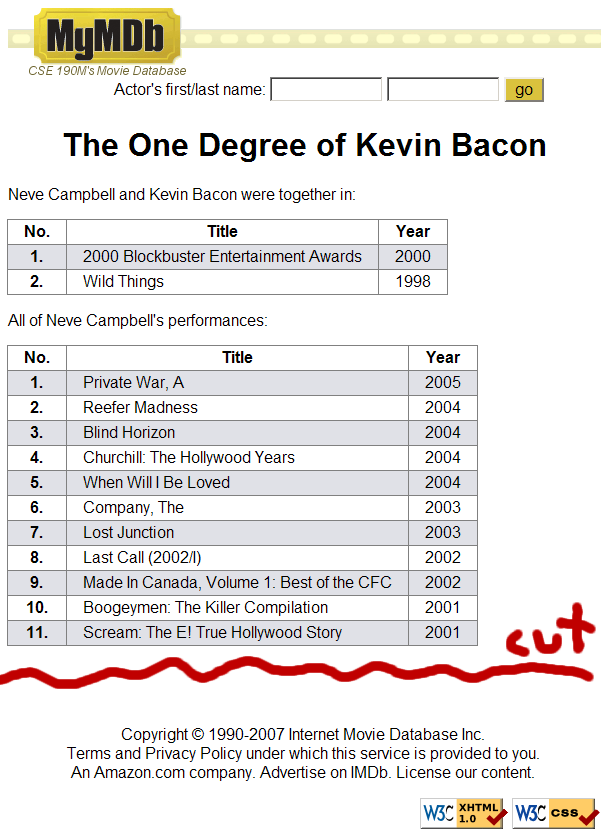This assignment asks you to use PHP and SQL. You will write the following page:


Your task for this assignment is to write the HTML and PHP code for a web site called MyMDb that mimics some of the functionality of the popular IMDb movie database site. The main ability of your site will be to link other actors to Kevin Bacon. If you prefer, you may use another actor of your choice rather than Bacon as the center point. The site will also let the user search for an actor by an approximate name, as well as displaying all movies by a given actor.
The site will consist of pages called index.php and results.php. The index.php page contains some initial content of your choice (described later) along with a form for a user to search for information about an actor. When the user submits a search, the browser is redirected to results.php, which displays the search results.
Turn in the two .php files mentioned previously, along with any other files you create. You should have a .css stylesheet file for any stylistic information. You should also identify common pieces of text or code and express these as separate files that are included in your pages.
Part of your grade will come from posting your program to exactly the following URL:
https://students.washington.edu/your_UWnetID/cse190m/homework/8/
Page Appearance - Both Pages:
The images referred to in this document exist in the following folder:
http://www.cs.washington.edu/education/courses/cse190m/CurrentQtr/homework/8-kevin_bacon/images/
All pages have a title of The CSE 190M Internet Movie Database (MyMDb) and a "favorites icon" of mymdb_icon.gif. The font of all text on all pages is 12pt Arial, or the default sans-serif font on the system.
All pages begin with the MyMDB logo image of mymdb.png. Spanning behind this is a horizontally repeating image of background.png. Below this is a form where the user can type an actor's first/last name, with a go button (colored DAC23D) that submits the form data to results.php. You may use either a GET or POST request as you see fit.
Below the form is a central area in which results are displayed. In index.php this area contains custom content of your own. You must include at least one image of Kevin Bacon (or the actor of your choice) and text explaining the program. Put as much content here as you like, even multimedia or links; be creative!
5em below this, the bottom of the page includes a paragraph of copyright information, followed by the standard W3C validator buttons in the right edge. The copyright information is:
Copyright © 1990-2007 Internet Movie Database Inc.
Terms and Privacy Policy under which this service is provided to you.
An Amazon.com company. Advertise on IMDb. License our content.
Page Appearance - results.php:
The central content area of the results.php page shows various content dependent on the query the user submitted. There are several cases that your code must handle:
Blank name:
Your page should handle specially the case where both the first and last name are blank. Your code should not display any data nor perform any database queries if both names are blank. This is done to save wear and tear on the poor database server, which might otherwise return ALL actors from such a case.
(a) Name doesn't match any actor in the database:
Your central content area should contain a paragraph with the following message, where [NAME] is the name the user typed (first name, space, last name):
Sorry, there were no actors matching [NAME].
You can determine how many actors match a given name by seeing how many rows were returned from your query. Do this by calling the mysql_num_rows function as described in the SQL lecture slides.
(b) Name matches multiple actors in the database:
This is likely to happen for many actor names, such as partial names, names with only a first or last name entered, or common names (such as Will Smith). In such a case, your page should display a heading saying "Actors matching [NAME]". Under this heading should be an list of actors in the database that matched the submitted name text, sorted by last name and then by first name. Show any names in the database in which the user's first and last name text matched as a substring; for example, if the user types "oh" as the first name and "sack" as the last name, the matching actors are "John Cusack" and "John Sackman".
Each of the names shown should be a link to load results.php with that actor's name as the query. For example, clicking "John Cusack" would reload results.php and show information about John Cusack.
(c) Name matches a single actor in the database:
If the user types an actor name that uniquely matches one actor in the database, you should perform two queries on the database. The first is to see in which movies, if any, that actor performed with Kevin Bacon (or the actor of your choice). Any such movies should be displayed as an HTML table. If the actor has not been in any movies with Kevin Bacon, your page should display this message instead of the table:
[NAME] wasn't in anything with Kevin Bacon.
The second query your page should perform is to find a complete list of movies in which the actor has performed. These movies should be displayed as a second HTML table.
The data of both tables is sorted in descending order by year. Both tables have three columns: A number for each movie, starting at 1; the movie's title; and the year of release. The columns have bold centered headings. The movies' background colors alternate between E0E1E7 (odd numbers) and white (even numbers). Cells have 1em of padding on their left and right sides, and 0.1em of padding on their top and bottom. The table and cells have a collapsed 1px solid gray border.

Screenshots in this document are from Windows XP in Firefox 2.0, which may differ from your system.
Database and Queries:
Your pages reads their data from a MySQL database named imdb, which is located on the server named webster.cs.washington.edu. Your code can query this database using PHP's MySQL functions. You will log in to this database using your UW NetID as your user name, and a password that will be emailed to you. The database contains the following tables:
Actor (id, fname, lname, gender)
Cast (aid, mid, Role)
Movie (id, name, year)
To solve this program, you'll need to come up with three unique SQL queries on the database. They are listed below in order from easiest to hardest. This is the order in which we recommend you develop them.
- A query to find all the actors whose names match the first/last name the user typed.
- Use the
LIKE clause to search for first/last names that contain the user's query text as a substring.
- A query to find all movies in which an actor has performed. To find this information, you will need to use a join between several tables of the database. The Cast table provides the link between a given actor's ID and the IDs of the movies he/she has been in. The Movie table gives you the other information about a movie, given its ID. You should acquire all of this information with a single SQL query; it is not acceptable to perform many queries (such as one per movie) to do so.
- Use a
FROM clause with several tables listed, or a JOIN clause, to perform a join in your query. Use ORDER BY to sort your results.
Hint: You will need to join the Actor, Cast, and Movie tables, and only retain rows where the various IDs from the tables (actor ID, movie ID) match each other and the ID of your actor.
Our query names 3 tables in the FROM clause and 3 WHERE conditions separated by AND.
- A query to find all movies in which both your actor and Kevin Bacon have performed together. As with the preceding query, this one involves join operations. This query involves more joining, because you must link not only your actor's ID to the movie, but also Kevin Bacon's.
Your queries should be constructed so that they effectively filter the data down to only results that are relevant. It is not acceptable to perform a query that returns too many results, then trim it down in your PHP code. For example, an incorrect way to find all movies the actor has been in with Kevin Bacon would be to get all of the actor's movies with one query, get all of Kevin Bacon's movies with another query, and then use PHP code to merge the two. This is unacceptable because it is taxing on the database server.
Small Database, SSH, and Wall of Shame:
Because the overall imdb database is so large, it can be very costly to perform a malformed query on it. This database will be used by all students, so a poorly written program can affect performance for everyone.
To address this problem, we have created a database named imdb_small that contains a smaller set of records. While you are debugging your code, please point it at that database rather than at the full imdb database. When you are reasonably sure that you have your program working, then you can switch to the full imdb dataset.
To discourage students from crashing or overloading the database server, we will post a "wall of shame" on the course web site. This wall will list the partial names of any students who break the server. (This is intended to be light-hearted; no actual punishment will occur for such mistakes.)
We also encourage you to test your queries on MySQL directly before running them as PHP code. To do this, connect to webster.cs.washington.edu using SSH, and then type the command mysql -u YOUR_USER_NAME -p and press Enter. It will ask for your SQL password as sent to you by email. Once you're in the MySQL prompt, type USE imdb; or USE imdb_small; to connect to the database, and then issue queries as normal. Press Ctrl-C to cancel a query in progress, and type quit to exit MySQL.
Except where otherwise noted, the contents of this presentation are © Copyright 2007 Marty Stepp and are licensed under the Creative Commons Attribution 2.5 License.




